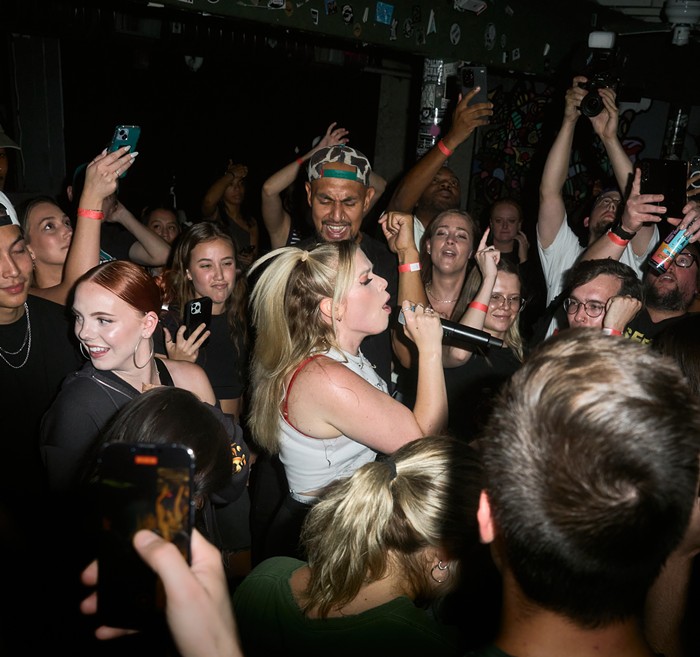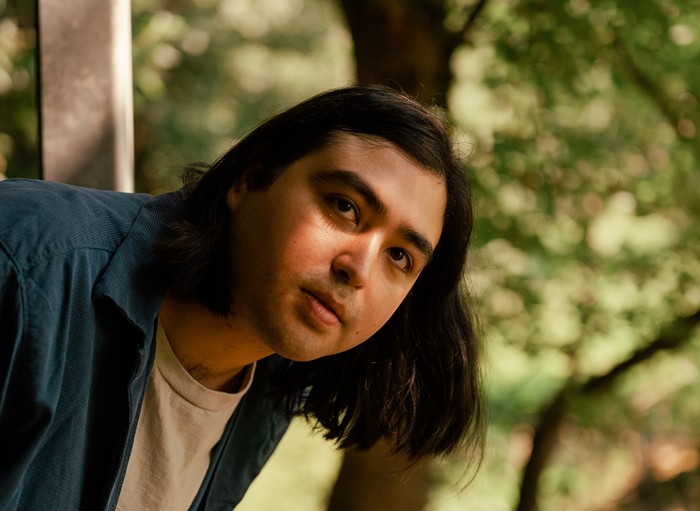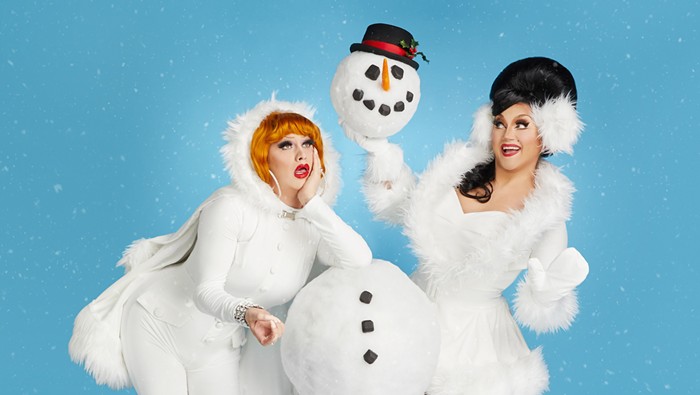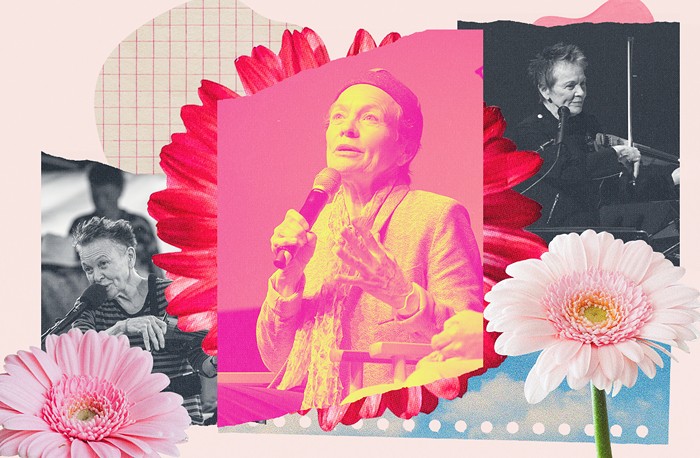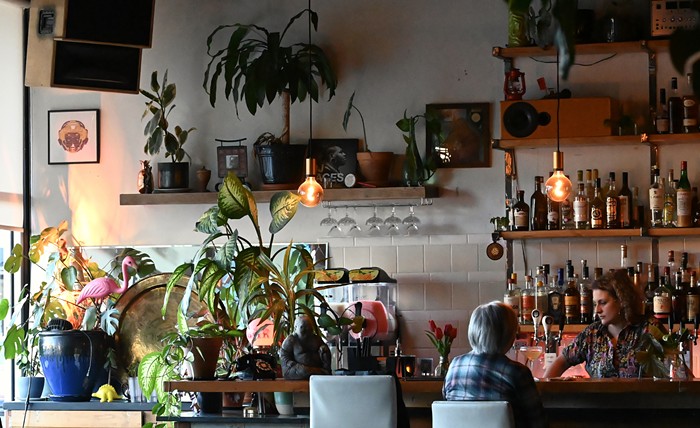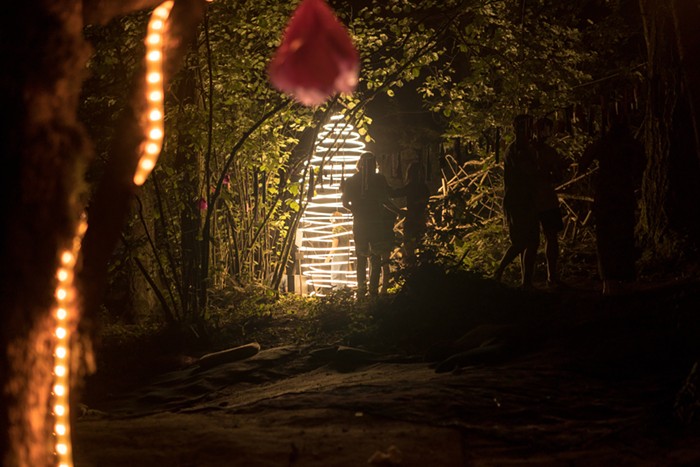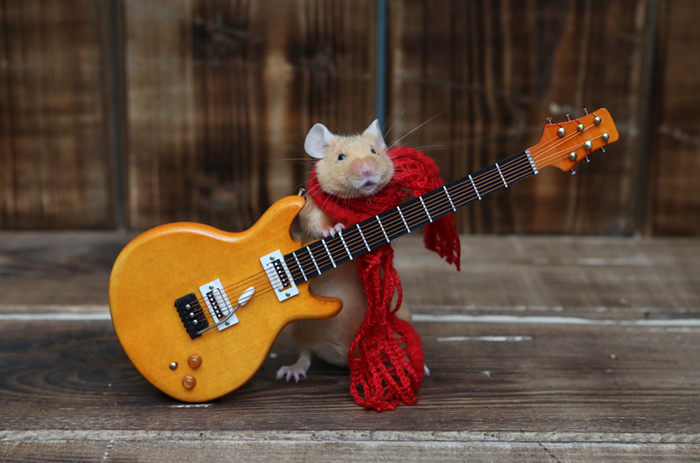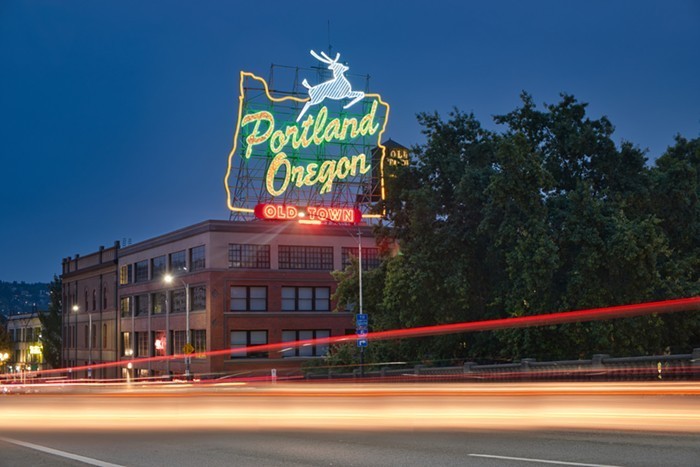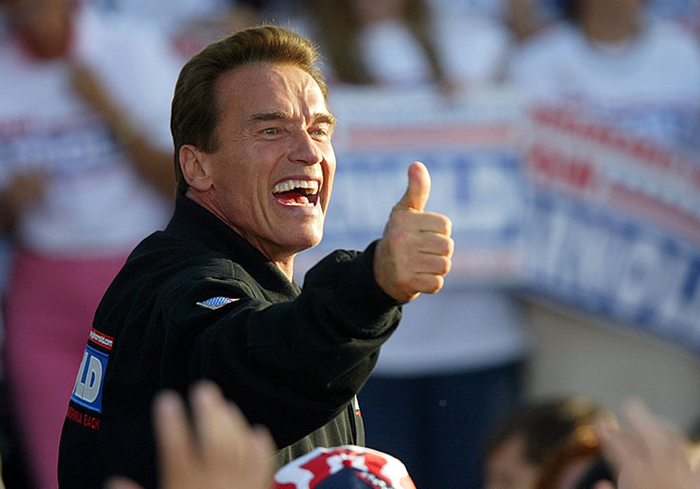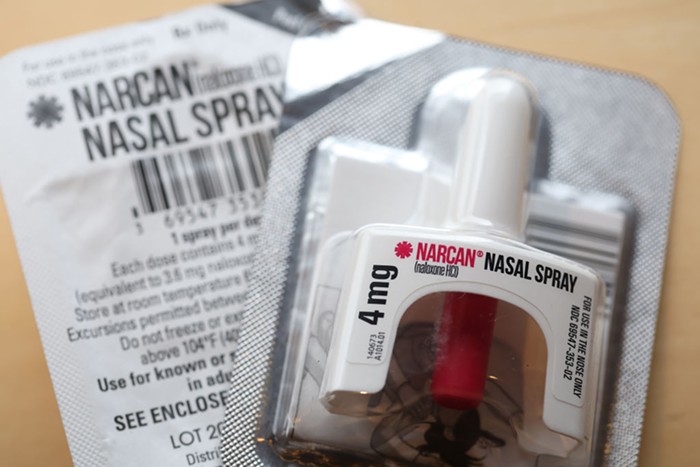I am walking down E 6th Street in Austin, Texas, wearing a goddamn fanny pack.
Well, it isn't exactly a fanny pack; it's more of a non-specific zippered hiking pouch thing, and I'm wearing it slung across my shoulders as opposed to nestled up against my rump, but I still feel like a geeky tourist.
It can't be helped. I'm packed to the gills as I roam South by Southwest (SXSW), and my standard practice of shoving everything in my pockets simply isn't going to cut it. I am carrying: notepad, camera, audio recorder, map, earplugs, Chaser hangover pills, hotel key, badge, and—most valuable of all, and taking up the most room—a list of the shows taking place over the next four days. So many shows, so many venues. Pages and pages of them, both in the official SXSW brochure (a slim 72-page volume) and in dozens of compiled computer printouts and emails detailing the unofficial parties, where bands blow through sets like candy, each and every musician trying to get as much exposure as humanly possible.
It's a rich, intertwined mixture of exciting and overwhelming. I feel the English language lacks the vocabulary to describe the precise combination of sensations. Something like the Chinese shared word for both "crisis" and "opportunity."
Austin is perhaps the only place currently giving Portland a run for its money as the unofficial, arguable, un-prove-able bearer of the title "Hippest City in the US." If you think Portland is the end-all be-all, just remember that we stole our "Keep Portland Weird" bumper sticker from Austin. The capital of Texas is packed with college students, government wonks, artsy hipster bikers, and incredible Mexican food. There's good public transport, a remarkably sturdy infrastructure (which SXSW tests to its very limits), and plenty of nature just a short drive from the city. Most importantly, there is the thriving—no, saturated—music scene. Austin is commonly referred to as the "live music capital of the world," and this reputation grows out of years of the city being defined by what it is not—much in the same way that Portland is not Seattle, Austin is not Nashville, and when outlaw artists like Willie Nelson fled the music business machinery of Nashville in the '70s, Austin is where they ended up.
The city is idyllic in March, before the incredibly hot summer kicks in. Spring daytime temperatures are perfect T-shirt weather, and the indoors don't get too unbearably hot when the music festival draws thousands upon thousands of musicgoers to Austin's various clubs and impromptu venues. This year, well over 1,800 bands are cramming into the city to either take part in the festival or set up stakes nearby to attract some of the spillover attention. Make hay when the sun shines, the adage goes—or in SXSW's case, make noise when there are as many people to hear it as possible.
SXSW isn't just a music festival; it's also a conference and trade show, and there's an entire stodgy element to the whole affair that takes place within the boring walls of the hulking Austin Convention Center. Most visitors won't ever set foot in the place except to register and pick up the ever-essential bracelet for $165 (or, if they're lucky and/or loaded, the $695 badge, which bumps you to the front of all the lines). The daytime conference is the schmooziest of affairs, with wheelers and dealers and hangers-on going to hear keynote speakers like Quincy Jones and mastering engineer Bob Ludwig. There's even something called a "demo listening session," which sounds absolutely horrifying for all involved. SXSW began in 1987, but it wasn't until the early '90s that it became the mammoth it is today, adding a film conference, and more recently, an interactive conference. There's even an associated SXSW golf tournament, for pete's sake.
The huge amount of stuff happening at any given time at SXSW cries out to be communicated as quickly as possible, and the spontaneous conduit of today's internet is seemingly tailor-made for covering it all. (Actually, this might not be a coincidence: Twitter debuted at SXSW Interactive in 2007.) Up-to-the-minute reviews are posted live; photos are uploaded and tagged; Twitter and Facebook headlines provide succinct assessments of what's happening at any given moment. This year, the sheer amount of data being transmitted through iPhones at SXSW quickly overloaded AT&T's network, leaving many stranded without use of their phones for hours at a time, and forcing AT&T to double their capacity in the Austin area. Even stranger, scores of people who didn't attend SXSW this year communicated online via Twitter to update each other on what they weren't doing, who they weren't seeing, and what wasn't happening at that very moment, tagging their posts and Flickr photos with "notatsxsw." The online coverage of SXSW is so big it's spawned a mirror opposite of itself.
I'm in Austin in an ostensibly professional capacity, but secretly I am just as excited as any fan by the gigantic pudding of live music I'm plunging into. I'm supposed to see as much as possible—various friends and colleagues have told me I must see this and I cannot miss that, having become the vessel for their vicarious SXSW experience—but more importantly, I've been given strict instructions to blog valiantly about the whole thing. This sounds easy, but I am not prepared for how exhausting it all is. After standing upright for one day straight, my legs turn to jelly. After two days of 14-hour drinking sessions, my decision-making abilities become surprisingly unreliable. After three days of incredibly loud music—since the bands are all right next to each other, each must crank the volume in order to be heard—my ears rebel outright, and cease being able to evaluate what they're hearing.
But I reckon the bands have it harder, particularly the ones with multiple shows scheduled each day. There's nothing easy about finding the various venues, getting there on time, loading in and out while the van is parked blocks away, and wrangling other members of the band who have been distracted by delicious tacos from the nearby carts.
Phil Bauer (AKA Ethic) of Portland hiphop ensemble Sandpeople tells me what his crew is hoping to get out of this year's SXSW. "We've created a bit of a buzz locally, and are getting a strong, consistent draw, so we see an opportunity to take what we're able to do with Sandpeople and move that elsewhere. So one of our big focal points for coming here is to try and link up with a couple independent booking agents doing showcases here, and see if there's any availability or any interest in helping us cultivate what we have, because we feel like we're really just a few rungs away from just bubbling up.
"A lot of the opportunities spring from being social," Bauer continues, "just having fun and striking up conversations, just finding a party that people we might want to talk to will be at, and really just being in the moment and the environment and just letting things happen. We're also trying to network, but at the same time there's a place for structured networking, and more sort of organic networking."
Mike Jones of Cravedog/CDForge, a disc, vinyl, and apparel manufacturing firm based in Portland, agrees. "The thing that SXSW has always been good for [for] me has been to establish or develop my existing contact base by seeing people that come regularly and meeting new people through my existing network of friends and business associates. So this is just a good atmosphere for it, because the bands are here, the labels are here, my competitors are here; there's just a lot of opportunity, but it's not a very organized event where you sit down and have meeting after meeting, because there's all this party activity. So a lot of it's a bit random in the way it happens."
Jones has been coming to SXSW for years, and he tells me, "This is the first year that I haven't seen people walking down the streets with badges hanging around their necks. There's hardly anybody here with a badge on. Less people are registering and paying the full $700 to come to SXSW. They're using it as a place to meet people, but they're not using the conference, per se. If I had to do it over again, I don't know that I'd really even buy a wristband. Most of the shows, we'd have been able to get in without one."
He's right. The daytime shows are all free, and while some of the bigger ones require an RSVP, a SXSW badge or wristband is no good. Only the official SXSW evening showcases require them, but there are dozens of other shows that fall outside of the organized affair. For example, the Levi's/Fader Fort is a huge corporate party palace erected in an old warehouse; fans who responded to the online RSVP are treated to free alcohol and sets from, among many others, up-and-comers the Pains of Being Pure at Heart, established indie favorites Peter Bjorn and John, and a surprise appearance from superstar Kanye West. Meanwhile, the dusty parking backyard of Ms. Bea's, a BBQ shack a few blocks down from the main drag on E 6th, is host to a huge list of DIY bands playing for free, including Phosphorescent, Vivian Girls, and Wavves. Green, grassy Waterloo Park, a stone's throw away from the state capitol building, is home to an all-afternoon party called "Mess with Texas" where bands like the Thermals and Black Lips play nonstop sets on two separate stages. And most legendarily, there are underground shows at 2 am, where a generator, a few bands, and a couple hundred kids all crowd in the dead of night onto the precariously swaying Lamar Pedestrian Bridge.
These types of shows are, in my opinion, the essence and the true value of the SXSW experience. With the major-label record industry virtually extinct, more power is in the hands of the music fan than ever: Full access to artists' entire catalogs, be it legal or illegal, is available with the click of a mouse, and the artists are subsequently empowered by this direct link to their fans. As Bauer says, "Especially with the economy being the way it is, the fans are out here because they love the music. This is a good spot for artists who're doing things on their own to really get a connection, maybe with a booking agent rather than a label, or a publicity company or someone that does radio. Maybe it's less about the label and more about the connections the labels have had historically that artists haven't been granted access to. I'm seeing that on our side. It's like, we're down here as our label, we're not down here with our label."
This paradigm shift is no more apparent than when Metallica's oversized tour bus plops down outside of the club Stubb's, clogging up the already straining thoroughfare. The Mighty Destroyers of All that Is File-Sharing play a small club show, taking up an all-important slot that an up-and-coming band could potentially have used to foster valuable attention, just so these enormous rock stars can glom onto the fan-generated buzz that a small, hip gig at SXSW can provide. It's a publicity stunt, pure and simple, and while the Righteous Enemies of Napster aren't exactly giving their music away, they want to look as if they're coming down off the mountain to mingle with the masses.
"It's fun, but it becomes less and less fun with every passing year," says Joan Hiller Depper, whose Riot Act Media publicity firm recently relocated to Portland. "SXSW gets bigger and bigger, and it becomes more and more difficult to get into shows, more and more difficult to plan your day or run into people, so as it's become an increasingly huge clusterfuck, it becomes harder to actually get the work done that you're here for.
"But it's always fun to see friends," she quickly adds. "It's always fun to see friends' bands."
I'm invited up to a plush hotel room on the 15th floor of the Omni, right smack dab in the center of things. I get the opportunity to stand on the balcony, overlooking almost all of downtown Austin. Stemming from the intersection of E 6th and Red River, every bar, venue, parking lot, and street corner flows out in each direction like blood vessels swimming with musicians. I finally gain a long-needed sense of perspective now that I see it all laid out beneath me.
A mishmash of sounds wafts upward to the balcony: crashing drums, wailing singers, distorted electric guitars, each competing to be the loudest. A few connected strains are audible, but it's largely a stew of noise. And that's all that is really happening here in Austin. It's a giant bath of music, with every hopeful band trying to be heard over everyone else. Some are more desperate than others; some are looking for long-term careers, agents, contracts, while others just want to have a good time. But everything is out there, in a fine, fun mess that's only notable for the condensed parameters of time and space in which it all takes place.
Beyond downtown, the rest of the city of Austin continues about its business as if SXSW isn't there. Farther out, the suburbs rest quietly. Even farther, as the sun sets slowly into the pink, is the long quiet line of the horizon, and the rest of the world beyond it, none of it seeming to pay SXSW any mind at all.
But for the thousands of people congregated around E 6th and Red River, one thing is shared: Music is their very favorite thing in the world, and these four exhausting, insane days exist to celebrate it.

